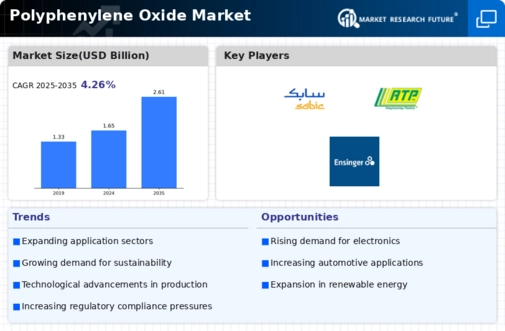Polyphenylene Oxide Market Summary
As per Market Research Future Analysis, the Global Polyphenylene Oxide Market was valued at USD 1.65 Billion in 2024 and is projected to reach USD 2.61 Billion by 2035, growing at a CAGR of 4.26% from 2025 to 2035. Key drivers include increased investment in infrastructure and a growing population, alongside rising demand for lightweight materials, particularly in the automotive and electrical sectors. The automotive segment is the largest application area, leveraging Polyphenylene Oxide's properties for interior and exterior components. North America leads the market, driven by established automotive and electronics industries, while the Asia-Pacific region is expected to grow the fastest due to rapid industrialization and urbanization.
Key Market Trends & Highlights
The Polyphenylene Oxide market is witnessing significant trends driven by demand for lightweight and high-performance materials.
- Automotive segment dominated the market, with extensive applications in vehicle components.
- Asia-Pacific expected to grow at the fastest CAGR from 2023 to 2032 due to industrialization.
- North America holds the largest market share, supported by strong automotive and electronics sectors.
- Rising demand for electric vehicles is propelling the adoption of Polyphenylene Oxide.
Market Size & Forecast
| 2024 Market Size | USD 1.65 Billion |
| 2035 Market Size | USD 2.61 Billion |
| CAGR (2024-2035) | 4.26% |
Major Players
Key players include BASF SE (Germany), SABIC (Saudi Arabia), RTP Company (US), Celanese Corporation (US), Ensinger Inc. (India), Mitsubishi Electric Corporation (Japan), 3M (US), Goodfellow (UK), Asahi Kasei Chemicals Corp. (Japan), Solvay SA (Belgium), Sumitomo Chemical Co., Ltd (Japan), LyondellBasell Industries Holdings BV (Netherlands).














